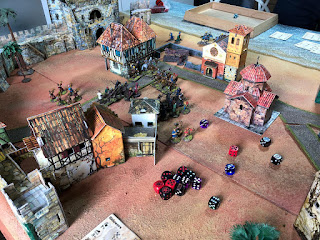Lion Rampant is a light ruleset that aims to recreate the clashes between retinues during the medieval period. The system is highly flexible and the scenarios included in the book allow recreating many different settings with few adaptations.
We played a scenario set during the beginning of the Crusaders States. A Crusader city has just been conquered by a large Seljuk force. A group of citizens has taken shelter at a fortress, and as the walls fall, decide to try to cross the city to reach the docks, where some ships, owned by the Maritime Republic of Genoa, are still at bay. We adapted the Scenario "The Convoy" from Lion Rampant, each token representing a bunch of civilians. Due to the urban setting, we decided to use the "reduced models" optional rule from Dragon Rampant to avoid cluttering too many models in small spaces, so we halved the miniatures needed for each unit. The Crusaders started on the NE deployment zone, while the Seljuks entered from the NW and SE deployment zone. The exit zone was the ship at the SW deployment zone.
I won't write up a detailed after-action record here, but overall the game was quite balanced, and until the last two turns all sides had a chance to win it. The Seljuk player resulted less effective in causing casualties and the Crusaders were good at protecting the foot serjeants' units carrying the civilians, allowing all the three groups to escape safely.
We had great fun, and the reduced models rule worked great. I suggest using it in an urban setting. It is also a great gateway, allowing new players to start playing with a few models. The second edition of Lion Rampant is going to be published in the next few months I hope it will implement this option.
This scenario was actually a playtest for an incoming project, keep following the blog for more details!
And now, some pictures! Crusaders are Normans from Conquest Games, Seljuks from Gripping Beast, and buildings and the ship from CleverPaper.














.jpeg)





.jpeg)

.jpeg)












